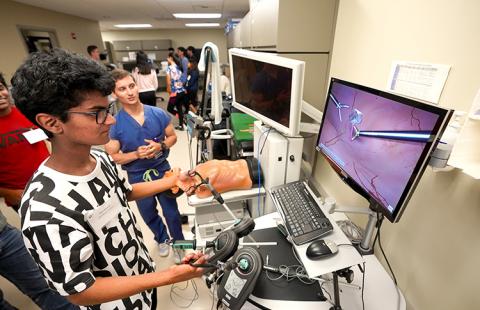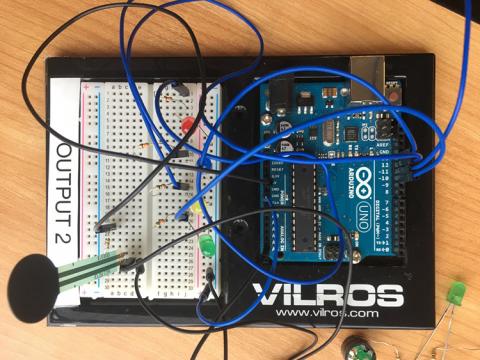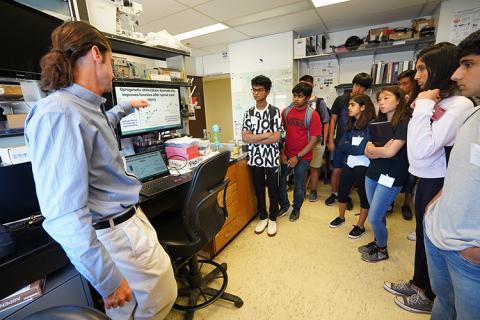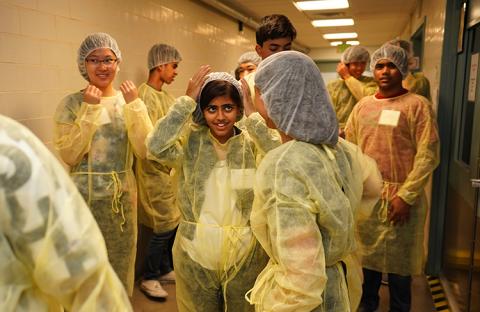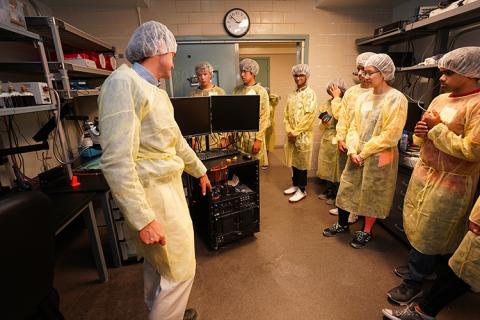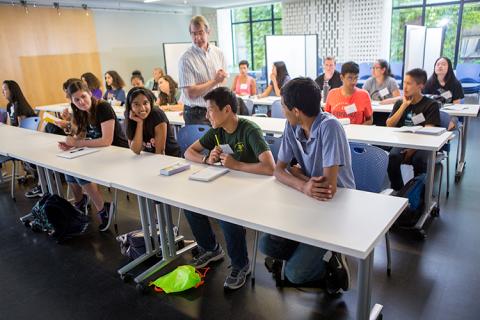This CNT summer program for high school students on the University of Washington’s Seattle campus gives students an introduction to neurotechnology development. YSP-REACH also facilitates conversations and experiences that help inform and guide students’ future academic and career choices.
Offered twice every summer, the Young Scholars Program (YSP-REACH) is a one-week boot camp where high school students learn the basics of neural engineering through lectures, lab visits and hands-on activities. Janis Wignall, the pre-college education manager at the CNT, said that this program reflects the Center for Neurotechnology’s (CNT’s) commitment to offering research experiences, classroom visits and outreach events for children, young people and educators.
“At the CNT, we’re living the goal of supporting science for future generations through higher education,” Wignall said. “It’s really about raising the standards of science so students can see themselves as researchers.”
A passion for science and its impact
Mehek Gosalia, a rising junior at Seattle’s Overlake School, found out about YSP-REACH after seeing posters put up around her high school. Her friend had also participated in YSP-REACH, and she spoke highly of her experience. Gosalia saw the program as an opportunity to learn about applications of computer science and engineering in the real world. Beyond that, Gosalia said that the program taught her about the broad applications of neuroscience in healthcare, technology and beyond.
“It’s an interdisciplinary and well-rounded experience,” Gosalia said. “You’re going to learn so much that can be applied to whatever you are interested in.”
Participating YSP-REACH students are selected for their passion for science, technology, engineering, and mathematics (STEM), and they are often participants of University of Washington (UW)-based programs at the Disabilities, Opportunities, Internetworking, and Technology center and Math Science Upward Bound.
“These are highly motivated students,” Wignall said. “They want something that’s rigorous, and they often have an interest in neuroscience.”
Gosalia said that students come in with a range of interests from bioengineering to computer science, but they all share a unifying passion for STEM.
“Even though that passion takes different forms, it makes for a fun camp experience because everyone is ready to learn and think about everything critically,” Gosalia said.
Translating neuroscience from the classroom to the lab
During the program, YSP-REACH students attend lectures about fundamental principles of neuroscience, and then apply these principles through hands-on activities. For example, students dissected a sheep brain, recorded neural signals from a cockroach leg, and visited the WWAMI Institute for Simulation in Healthcare, a surgical training facility used for healthcare education.
Laura Moore, a former Research Experience for Teachers participant and lead math and science teacher at Eton School in Bellevue, Washington, is currently working as a co-lead for YSP-REACH. When leading activities, she focused on creating a space where students can apply the engineering design process, which involves defining a problem, brainstorming and testing a solution, and communicating the results.
“I want to help students feel connected and heard, and I also encourage all students to share their ideas,” Moore said.
For example, students participate in an activity where they use different Arduino sensors to produce outputs such as light or sound. When teaching this workshop, Moore made connections between neural engineering concepts and the process of trial and error that often occurs in research.
“I acknowledge that there are different skill levels and interest levels, and I said that there was no one outcome,” Moore said. “I tell them, ‘in this moment, you are the expert and you decide what you need. If you want to experiment, knowing that the product may or may not happen, you may do that."
Exploring the applications of neuroscience research
Marley Goldman, a YSP-REACH student and rising senior at Woodinville High School, also learned from other students’ interest in neuroscience and its applications. For example, during the sensory Arduino activity, she worked with another student to prototype a sensory adaptation model of a prosthetic. One challenge of prosthetic limbs is that users may not know how firmly to grip different objects. To address this, their prototype had a light that became brighter with increasing pressure, which acted as a visual cue for the user.
“The other student and I were able to do different sides of the project,” Goldman said. “I was focusing on the concept in terms of brain function, and she was able to build it. It was cool to work with someone on the other side of the same project.”
Students also see how the engineering design process is being applied in CNT- affiliated labs, where they can hear from researchers themselves. For example, YSP-REACH students visited CNT Co-Director Chet Moritz’s CNT-affiliated lab to learn more about spinal stimulation, and how research models there are being applied in the Amplifying Movement & Performance Lab. For Goldman, these visits enabled her to see the researchers’ passion for their work and hear about their path to academia.
Sometimes, when you hear about someone who created deep brain stimulators, it sounded like an unachievable feat,” Goldman said. “But when they talked about being a research assistant and coming across setbacks, I felt inspired and reassured that I can make it happen. It doesn’t seem like such an impossible task.”
By visiting labs and learning about how research works in a college environment, YSP-REACH students can begin to see themselves contributing to the field of neural engineering.
“I’m going to be a lot more interested in my science classes and how they can connect to everything I’m interested in,” Gosalia said. “It’s a way to understand the world, not just a specific discipline.”
YSP-REACH also highlights the interdisciplinary nature of neural engineering research, and it has encouraged students like Gosalia to pursue projects of their own.
“Right now, I’m [developing] a more accessible way to teach music to visually impaired or hearing impaired students,” Gosalia said. “The CNT has inspired me to look for ways that my CS [computer science] interests can apply to other fields.”
Setting up high school students for success
YSP-REACH students also attended a neuroethics lecture that explored the impact of neurotechnology on end users.
“It encourages us to think broadly and in a different way. You’re not just thinking about how one person with different ability informs the ethics of [brain-computer interfaces],” Gosalia said. “You’re thinking of the opposing view as well, and how we can make sure both people have freedom and autonomy.”
Goldman said that the YSP-REACH students discussed the use of neurotechnology for people with neurodegenerative diseases versus cognitive augmentation for any end user. During their conversation, students discussed a future where neurotechnology is available to the public, and the question of who would have access to it.
“At YSP-REACH, everyone was there to see other’s points of view and learn from each other as well as the presenters,” Goldman said.
During the program, they also received advice about how to navigate a college environment.
That’s a way to treat the students holistically, not just teach them about neuroscience,” Wignall said. “It gives them perspective on how to be successful in college, which is also a bigger goal.”
Throughout the program, the students develop a community where they can share their interests and engage with the work of the CNT’s labs.
“When we’re walking between labs, we’ll be joking about getting lost on campus, but we’ll also discuss the role of AI [artificial intelligence] and the ethics of using [brain-computer interfaces],” Gosalia said.
Gosalia said that YSP-REACH offered networking opportunities with researchers and students, which translated into extended relationships beyond the program. In one instance, YSP-REACH students attended a panel with CNT-affiliated graduate students, and they asked questions about how to navigate college or find research opportunities.
“We got to talk to them and see what a college student’s life is like when they’re interested in these fields,” Gosalia said of the panel. “I also learned about how to get involved on campus, [and] adjust to the transition between high school and college.”
Now that YSP-REACH has ended, Goldman is gearing up to apply to the UW, and participating in YSP-REACH enabled her to visualize her life as a future pre-med student and neurologist.
“The Seattle area has always been my chosen home,” Goldman said. “Spending this time on campus, seeing the places I could work, and having connections through YSP-REACH has made me want to stay here more.”
Goldman encourages all high school students to consider the program, regardless of their level of familiarity with neuroscience and neurotechnology.
“As long as you have an interest in the brain and helping people, you should apply,” Goldman said. “You can come as you are, and it’s a welcoming environment.”
Learn more about YSP-REACH by contacting CNT Executive and Education Director, Eric Chudler.

